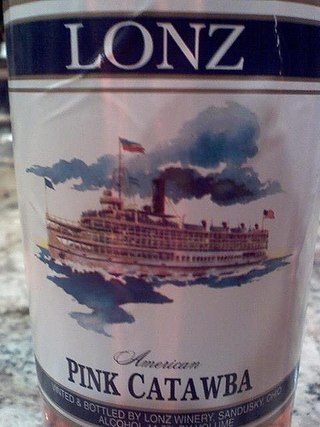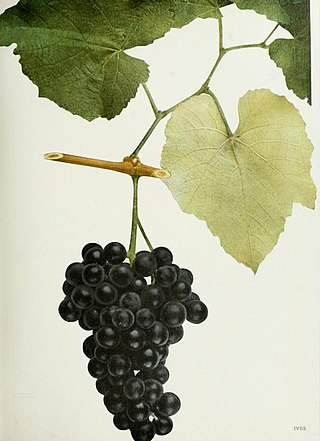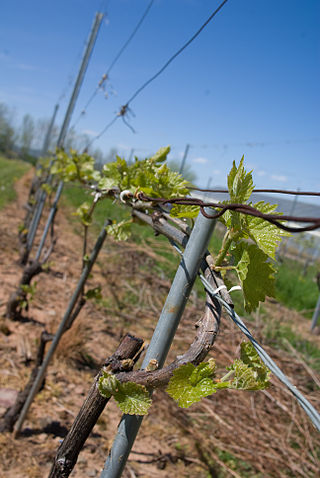Related Research Articles

The Concord grape is a cultivar derived from the grape species Vitis labrusca that are used as table grapes, wine grapes and juice grapes. They are often used to make grape jelly, grape juice, grape pies, grape-flavored soft drinks, and candy. The grape is sometimes used to make wine, particularly sacramental and kosher wine. Traditionally, most commercially produced Concord wines have been finished sweet, but dry versions are possible if adequate fruit ripeness is achieved. The grape is named after the town in Massachusetts where it was developed. The grapes are cultivated in many different parts of the world now.

Aurore is a white complex hybrid grape variety produced by Albert Seibel and used for wine production mostly in the United States and Canada. Over a long lifetime Seibel produced many complex hybrid crosses of Vitis vinifera to American grapes. It is a cross of Seibel 788 and Seibel 29.

Baco blanc or Baco 22A is a French-American hybrid grape variety. It is a cross of Folle blanche and the Noah grape, created in 1898 by the grape breeder François Baco. Folle blanche is its Vitis vinifera parent. Noah, its other parent, is itself a cross of Vitis labrusca and Vitis riparia.

Catawba is a red American grape variety used for wine as well as juice, jams and jellies. The grape can have a pronounced musky or "foxy" flavor. Grown predominantly on the East Coast of the United States, this purplish-red grape is a likely cross of the native American Vitis labrusca and the Vitis vinifera cultivar Semillon. Its exact origins are unclear but it seems to have originated somewhere on the East coast from the Carolinas to Maryland.

Vitis labrusca, the fox grape, is a species of grapevines belonging to the Vitis genus in the flowering plant family Vitaceae. The vines are native to eastern North America and are the source of many grape cultivars, including Catawba, Concord, Delaware, Isabella, Niagara, and many hybrid grape varieties such as Agawam, Alexander and Onaka. Among the characteristics of this vine species in contrast to the European wine grape Vitis vinifera are its "slip-skin" that allows the skin of the grape berries to easily slip off when squeezed, instead of crushing the pulp, and the presence of tendrils on every node of the cane. Another contrast with European vinifera is the characteristic "foxy" musk of V. labrusca, best known to most people through the Concord grape. This musk is not related to the mammalian fox, but rather to the strong, earthy aromas characteristic of the grapes that were known by early European-American settlers in the New World. The term "foxy" became a sort of catchall for the wine tasting descriptors used for these American wines that were distinct from the familiar flavors of the European viniferous wines.

Vitis rupestris is a species of grape native to the United States that is known by many common names including July, Coon, sand, sugar, beach, bush, currant, ingar, rock, and mountain grape. It is used for breeding several French-American hybrids as well as many root stocks.

Hybrid grapes are grape varieties that are the product of a crossing of two or more Vitis species. This is in contrast to crossings between grape varieties of the same species, typically Vitis vinifera, the European grapevine. Hybrid grapes are also referred to as inter-species crossings or "Modern Varieties." Due to their often excellent tolerance to powdery mildew, other fungal diseases, nematodes, and phylloxera, hybrid varieties have, to some extent, become a renewed focus for European breeding programs. The recently developed varieties are examples of newer hybrid grape varieties for European viticulturalists. Several North American breeding programs, such as those at Cornell and the University of Minnesota, focus exclusively on hybrid grapes, with active and successful programs, having created hundreds if not thousands of new varieties.

The Isabella grape is a cultivar derived from the grape species Vitis labrusca or 'fox grape,' which is used for table, juice and wine production.

Vitis (grapevine) is a genus of 79 accepted species of vining plants in the flowering plant family Vitaceae. The genus is made up of species predominantly from the Northern Hemisphere. It is economically important as the source of grapes, both for direct consumption of the fruit and for fermentation to produce wine. The study and cultivation of grapevines is called viticulture.

The Hermann AVA is an American Viticultural Area located in Gasconade County, Missouri, and entirely contained within the larger Ozark Mountain AVA. The wine appellation is located on the southern side of the Missouri River near the town of Hermann, about halfway between St. Louis and Jefferson City. The AVA covers the northernmost hills of the Ozark Plateau with many of the 200 acres of vineyards planted along hillside locations. As of 2007, seven wineries were producing wine in appellation, including Missouri's largest winery, Stone Hill Winery.

Clinton is a red variety of hybrid grape. Its phylloxera resistance led to its being planted in small amounts in the eastern Alps, although it imparts a pronounced foxiness and dark red colour to wine made from its juice.

Brazil is the third-largest producer of wine in South America, behind Argentina and Chile; production in 2018 was 3.1 million hectolitres (82,000,000 US gal), slightly more than New Zealand. In 2019, Brazil was the 15th largest wine producer in the world. A substantial area is devoted to viticulture: 82,000 hectares in 2018, though much of it produces table grapes rather than wine grapes.
Alexander is a spontaneous cross of vines from which the first commercial wines in America were made. It was discovered in 1740 in the neighborhood of Springgettsbury, Philadelphia, in a vineyard where James Alexander, Thomas Penn's gardener, had originally planted cuttings of Vitis vinifera in 1683. It was popularized by the Bartram family at Bartram's Garden, Philadelphia, and widely distributed after the American Revolution by William Bartram.
Cascade is a red complex hybrid grape variety that was created by French viticulturist Albert Seibel in the early 20th century in Aubenas, Ardèche, in the Rhône Valley. It has been commercially available in North America since 1938 and has since been planted in Canada and the United States. However, in warmer climates the grape is highly susceptible to a number of grapevine viruses, which has discouraged plantings of the variety.

Ives noir is a red hybrid grape variety that is grown throughout the United States. Named after its propagator, Connecticut wine grower Henry Ives, the grape's pedigree and exact origin are unclear. After Prohibition in the United States, Ives was a popular grape used in the production of sweet port-style wines but saw its plantings steadily decrease throughout the 20th century as the vine's susceptibility to air pollution took its toll.
Ravat blanc is a white hybrid grape variety that is a crossing of Chardonnay and a Seibel grape. While the Vitis International Variety Catalogue (VIVC) maintained by the Geilweilerhof Institute for Grape Breeding list Seibel 5474 as the second parent, Master of Wine Jancis Robinson notes that other authors list Seibel 8724 as the parent. The grape is often confused with the white hybrid grape Vignoles that is often called just Ravat.

Muscat bleu is a red Swiss wine and table grape variety that is a hybrid of Garnier 15-6 and Perle noire. The grape was developed in Peissy in the Canton of Geneva by Swiss grape breeder Charles Garnier in the 1930s. Today the grape is used as both a table grape and for winemaking, producing wines that Master of Wine Jancis Robinson describe as "soft and grapey". Outside Switzerland some plantings of Muscat bleu can also be found in Belgium.

L'Acadie blanc is a white Canadian wine grape variety that is a hybrid crossing of Cascade and Seyve-Villard 14-287. The grape was created in 1953 by grape breeder Ollie A. Bradt in Niagara, Ontario at the Vineland Horticultural Research Station which is now the Vineland Research and Innovation Centre. Today the grape is widely planted in Nova Scotia with some plantings in Quebec and Ontario. Some wine writers, including those at Appellation America, consider L'Acadie blanc as "Nova Scotia’s equivalent to Chardonnay".
Blanc du Bois is an American hybrid grape that was created in 1968 by John A. Mortensen at the University of Florida’s Central Florida Research and Education Center in Leesburg, Florida. Mortensen created this variety by crossing various Vitis vinifera grape varieties such as Golden Muscat with native Florida varieties. When released in 1987, Blanc du Bois became another grape variety in the small but growing number of vine types that can both produce marketable wine on their own yet can withstand Pierce's Disease, a bacterial infection that destroys nearly all vinifera vinestocks imported into the southern United States.
References
- ↑ Subramanian, C.V. (1956). "Phaeotrichoconis, a new genus of Dematiaceae". Proceedings of the Indian Academy of Sciences, Section B. 44 (1): 1–2.
- ↑ "Phaeotrichoconis crotalariae (M.A. Salam & P.N. Rao) Subram. :2, 1956". MycoBank. International Mycological Association. Retrieved 2012-12-26.
- ↑ Lima, Thaís Emanuelle Feijó de; Bezerra, José Luíz; Cavalcanti, Maria Auxiliadora de Queiroz (2012). "Phaeotrichoconis crotalariae, endophytic on Vitis labrusca in Brazil". Mycotaxon. 120: 219–4. doi: 10.5248/120.291 .